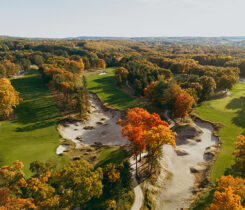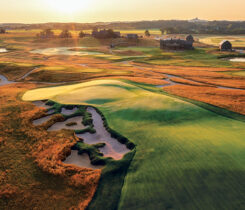The man in the mirror
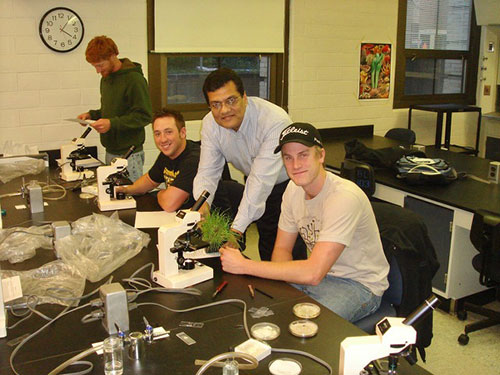
Wakar Uddin, Penn State plant pathologist (center). (Photo provided by Wakar Uddin)
You, dear superintendent, are the main cause of anthracnose outbursts.
Luckily, you also hold the keys to minimizing those problems.
Research from Ohio State University (OSU) says that mowing issues likely are the No. 1 factor that initiates the onset of anthracnose basal rot (ABR). If you send that crew to work without paying specific attention to mower heights and times, you have nobody else to blame.
Joe Rimelspach, plant pathologist at OSU, and Wakar Uddin, Penn State plant pathologist, have conducted thorough research on ABR and offer the following guidance.
Blame it on the rain
Minimize all mowing stress, Rimelspach advises. OSU research shows that a 0.015-inch increase in mowing height can result in an improvement of turf health and reduced anthracnose. Researchers simply raised the mower from 0.125 to 0.141 inch.
The key is to avoid scalping or cutting too low. This often is the bottom-line factor that leads to ABR problems, which are typical on annual bluegrass (Poa annua) and bentgrass.
A typical bentgrass plant with ABR will show foliar lesions reddish-brown in color. Older leaf blades get water soaked. On annual bluegrass, symptoms include elongated yellow leaf spots with small, black, spore-bearing structures in the center of the yellow blot.
Given weather conditions up and down the Atlantic seaboard this season, ABR problems have been early and extreme, according to Uddin.
“We have had high heat and heavy rain,” Uddin says. “Extreme heat and extreme moisture mean the problem showed up early.”
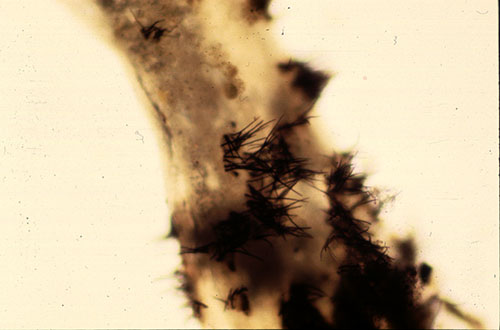
Profuse production of anthracnose fungal structures (Acervuli) on infected Poa annua plant. (Photo courtesy: Wakar Uddin, Ph.D., Penn State)
Not only does rain favor ABR outbreaks, it also makes timely application of fungicide more challenging. Efficacy of application depends on the mode of action of the material used and the interval between application of the fungicide and the next rain.
For courses using a systemic fungicide (the standard recommendation), a window of four to six hours of dry weather should give the chemical time to work into the plant.
Contact treatments usually are not practical for ABR under this sort of circumstance.
Uddin notes that most systemics transport up from the base of the plant into the leaf area. They are absorbed by either the root or the crown, then move upward. “It is best if there is no rain on the same day the application is made,” Uddin says. However, a superintendent can dodge a bullet if there is at least a four- to six-hour dry spell between the application and rainfall. In some areas of the mid-Atlantic this year, that has been a lot to ask of Mother Nature.
Rimelspach says his lab has seen some slippage in samples, probably because superintendents know the disease and are trying to stay ahead of it.
“The fungicides we have are excellent tools,” Rimelspach says. However, he warns against getting too aggressive and burning them out. Switching families is a good way to extend the efficacy of the materials.
While there is little new on the market this year, Rimelspach expects a couple of major companies to come out with new product. However, as DMIs and SDHIs, they will be in the families superintendents use already.
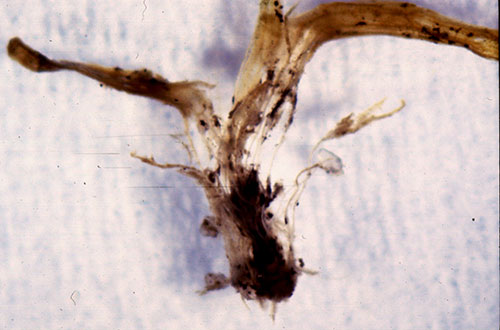
Deterioration of Poa annua crown tissue infected by anthracnose fungus. (Photo courtesy: Wakar Uddin, Ph.D., Penn State)
Beyond chemicals
Never mow when greens are wet, soft or spongy, Rimelspach says. Use solid rollers. Grooved rollers usually lead to a lower cut and stressed plants… and, eventually, ABR.
OSU research shows that rolling greens to smooth the surface improves mowing quality. This in turn may reduce mowing frequency and allow increasing the height of cut. Use smooth rollers, Rimelspach says. Skip the clean-up passes. Keep mower blades sharp.
“If you get lots of rain and have any flaw in your drainage, you’re a sitting duck for ABR,” Rimelspach says. “Drainage is key. It’s not cheap — but it is key.” That is true both for bent and Poa annua greens. He points to a Cincinnati-area course with Poa greens and no budget for renovating its drainage. It got socked with ABR.
“It’s like driving a Model-T to Florida. You’ll probably get there… but you’ll have a lot of breakdowns on the way,” Rimelspach says of antiquated or marginal drainage.
While it’s more labor-intensive, use walk-behind greens mowers whenever possible. Reduce mowing frequency. When you do mow, floating-head mowers should be the preferred equipment. This may be a real headache when there are several days of continuous rain.
“Players have to compromise,” Uddin says, noting that the golfer’s default desire for greens height is lower. He understands both sides of the issue. “Yes, you don’t want to be playing in a corn field… but the lower you mow, the more disease the members will see.”
Whatever you do, avoid practices that injure the plant in any way, especially the crown. Uddin advises against verticutting or spiking greens under pressure. “That will cause injury that will lead to infection,” he explains.
Bruising plant tissue not only give spores an entry site for infecting healthy turf, but disturbing the turf encourages spread of the disease. Anthracnose spores have a gelatinous matrix that allows them to stick to equipment like tines and mowers. The result is movement of spores from green to green.
Fertility tips
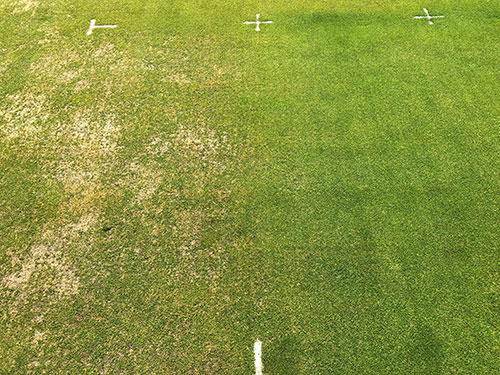
Anthracnose basal rot damage on Poa annua and the result of excellent chemical control on right. (Photo courtesy: Wakar Uddin, Ph.D., Penn State)
Other factors that superintendents control also can minimize ABR. Fertility is another key to maintaining healthy turf and managing ABR. Maintain greens with a sound fertility program for healthy turfgrass. Shoot for a minimum of 3 pounds of N per 1,000 square feet annually.
Uddin recommends spoon feeding greens likely to be under anthracnose stress. “Using slow-release material is best,” he says.
Do not under-fertilize greens to achieve speed. Rather, fertilize for turf health, Rimelspach advises. “Don’t starve them.”
Many superintendents turn to granular materials in the cooler parts of the season, both early and late. Others spoon feed year-round. The focus always is to keep the grass healthy. To that end, apply 0.1- to 0.125 pound of N from ammonium sulfate or urea every seven to 14 days. Tank mix it with fungicide applications.
Maintain growth but avoid surges of growth, he says. Right now, OSU is doing further research to determine the best nitrogen and nutrient forms to use.
While you’re at it, avoid overwatering and excessively wet soils and conditions of continuously wet thatch.
Avoid extremes in soil moisture. Syringe to prevent wilt. The goal is healthy turfgrass. Improve drainage to maximize turfgrass health and vigor. This may mean installing drainage systems or rebuilding greens to correct drainage problems.
While they are long-term solutions to a recurring challenge, superintendents who survive this year’s soggy season will have to be alert next year for any residual effects of ABR on the course.
| Product | Rate* (oz/1,000 sq ft) | Family | Mobility |
| Chlorothalonil | 3.25 – 5.0 oz** | Nitrile | Contact |
| Medallion | 0.25 – 0.5 oz | Phenylpyrolle | Contact |
| Secure | 0.5 oz | Pyridinamine | Contact |
| CL 3336 | 4.0 – 6.0 oz | Benzimidazole | Systemic (upward) |
| Endorse | 4.0 oz | Polyoxin | Local Penetrant |
| Heritage | 0.2 – 0.4 oz | Strobilurin | Systemic (upward) |
| Compass | 0.25 oz | Strobilurin | Local Penetrant |
| Insignia | 0.5 – 0.9 oz | Strobilurin | Local Penetrant |
| Disarm | 0.18 – 0.36 oz | Strobilurin | Systemic (upward) |
| Banner MAXX | 1.0 – 2.0 oz | SI/DMI | Systemic (upward) |
| Bayleton 50W | 0.5 – 1.0 oz | SI/DMI | Systemic (upward) |
| Eagle 20EW | 0.2 oz | SI/DMI | Systemic (upward) |
| Trinity | 0.5 – 1.0 oz | SI/DMI | Systemic (upward) |
| Tourney | 0.28 – 0.37 oz | SI/DMI | Systemic (upward) |
| Chipco Triton | 0.15 – 0.30 oz | SI/DMI | Systemic (upward) |
| Torque | 0.6 oz | SI/DMI | Systemic (upward) |
| Chipco Signature*** | 4.0 oz | Phosphite | Systemic (upward and down) |
| Velista | 0.3 – 0.5 oz | Carboxamide/SDHI | Systemic (upward) |
* The rates are general guidelines, ALWAYS FOLLOW LABEL RECOMMENDATIONS.
** Dry weight in ounces, there are also liquid/flowable formulations so READ AND FOLLOW THE LABEL.
*** Other phosphite products have shown reduced anthracnose in some studies.









